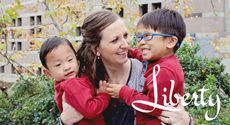I look at our amazing little girl and try to imagine her birth mother. I know that some, if not many, of Cholita’s traits must have come from her. I feel certain that she’s a smart and charming woman, with a beautiful face and determined will. She probably has great dexterity, a propensity toward impatience, and may have an obsession with shoes. I also know that she almost certainly has hepatitis.
Over the weekend, on a beautiful sunny morning in the Pacific Northwest, I sat inside a conference room in the Asian Cultural Center in Seattle. I was one of only a handful of people not wearing headphones. The doctors presenting that day spoke in English and translations came through the headphones in Mandarin, Cantonese, Vietnamese and Korean. There were whole families in attendance. At the table next to me sat an elderly woman with her daughter and her two teenaged granddaughters. They were learning about a disease that had been passed down through their family for generations: Hepatitis B.
One woman asked through her translator why the virus seems to target Asians. Why are 1 out of every 5 people in China reportedly infected with the virus? Why are Asians in the U.S. ten times more likely to test Hep. B positive than Caucasians? The doctor explained that it is not a racial preference. It all boils down to money. Yes, the virus has been in Asia for hundreds of years, recently found in the tissue of a 500 year old mummy in Korea, but it’s the lack of money for immunization that has kept the virus thriving.
Historically, the most common mode of transmission by far has been mother to child. Today, a pregnant woman with Hepatitis B has an excellent chance of preventing the virus from spreading to her baby. She can also protect her own health during her pregnancy with new antivirals that do not harm the infant. Immediately after birth, the baby will be given a Hepatitis B immunoglobulin shot and start the 3 shot immunization series. Following this simple routine, over ninety percent of these babies will live their lives hepatitis free. If they don’t begin these shots within that first 24 hours, and they contract the virus as a newborn, over 90% will chronically have the virus for the rest of their lives. It’s a small and crucial window.
Those granddaughters sitting next to me at the conference, at least three generations removed from the start of the virus in their family, will put an end to the cycle. It’s something I feel sure Cholita’s birth mother would have done had she known or had the means to do it. During a break in the conference, I struck up a conversation with the family. I showed them Cholita’s picture and the grandmother oohed and ahhed and unable to speak English, pointed at the picture and asked, “Gon yen?” Not knowing what that meant, I looked to the granddaughters. “Gon yen?” the grandmother said to them, pointing again to Cholita. The elder granddaughter said, “She wants to know if your daughter has hepatitis.” I nodded to the grandmother. “She did,” I told them, “but she’s better now.” The granddaughter translated and then the grandmother kissed Cholita’s picture, then put it down and clapped. It’s what mothers everywhere want for their children: a healthy future.



























Leave a Reply